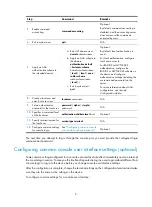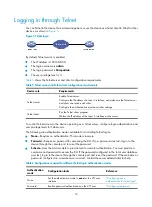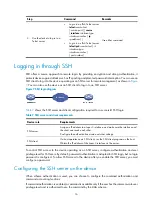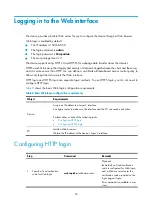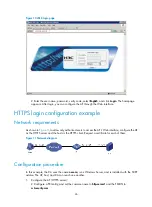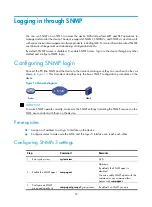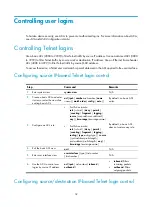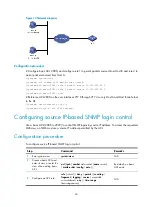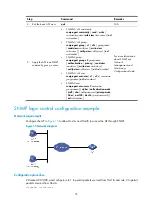
22
by the device itself, rather than a CA) and the default SSL settings. This mode is simple to configure
but has potential security risks.
•
Secure mode
—To make the device operate in this mode, you must enable HTTPS service on the
device, specify an SSL server policy for the service, and configure PKI domain-related parameters.
This mode is more complicated to configure but provides higher security.
For more information about SSL and PKI, see
Security Configuration Guide.
Follow these guidelines when you configure HTTPS login:
•
If the HTTPS service and the SSL VPN service use the same port number, they must have the same
SSL server policy. Otherwise, only one of the two services can be enabled.
•
If the HTTPS service and the SSL VPN service use the same port number and the same SSL server
policy, disable the two services before you modify the SSL server policy, and re-enable them after
the modification. Otherwise, the SSL server policy does not take effect.
To configure HTTPS login:
Step Command
Remarks
1.
Specify a fixed verification
code for Web login.
web captcha
verification-code
Optional.
By default, no fixed verification code is
configured for Web login, and a Web
user must enter the verification code
provided on the login page at login.
This command is available in user view.
2.
Enter system view.
system-view
N/A
3.
Associate the HTTPS
service with an SSL server
policy.
ip https ssl-server-policy
policy-name
Optional.
By default, the HTTPS service is not
associated with any SSL server policy,
and the device uses a self-signed
certificate for authentication.
Disabling the HTTPS service
de-associates the SSL service policy from
the HTTPS service. To re-enable the
HTTPS service, you must reconfigure this
command again.
If the HTTPS service has been enabled,
any changes to the SSL server policy
associated with it do not take effect.
4.
Enable the HTTPS service.
ip https enable
By default, HTTPS is disabled.
Enabling the HTTPS service triggers an
SSL handshake negotiation process:
•
If a local certificate exists on the
device, the SSL negotiation
succeeds and the HTTPS service
starts up.
•
If no local certificate exists, a
certificate application process is
triggered by the SSL handshake
negotiation. Because the
application process takes a long
time, the SSL negotiation often fails

